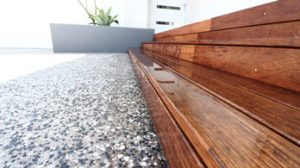Tips to Install Exposed Aggregate
- August 27, 2024
- Written By Brad Russell
- Design Trends

Exposed aggregate concrete is a popular choice when it comes to residential and commercial projects, especially driveways and alfresco areas. This is because of exposed aggregate’s high levels of durability and versatility. No matter the project, there is a type of exposed aggregate concrete for nearly every taste and budget. The best part? It’s easy and quick to install! Learn how to install exposed aggregate concrete in this blog.
How to Install Exposed Aggregate
Installing exposed aggregate concrete can be challenging; you must prepare your surface, mix the concrete in the correct proportions, then pour, level, expose the aggregate, cure, and seal. Each step must be correct, or you risk the concrete cracking and your efforts wasted. Generally, this is not a project for inexperienced do-it-yourselfers. For those seeking professional assistance, our concrete installation services are available.
What is Exposed Aggregate Concrete?
While we offer numerous types of concrete designed to be beautiful additions to your home, exposed aggregate offers you a one-of-a-kind customised concrete surface. Exposed aggregate is a type of decorative pavement generally used in outdoor spaces. It begins with a concrete base that is topped by a layer of concrete mixed with sand, cement, and other ornamental elements like stones, pebbles, shells, granite, or gravel.
The one-of-a-kind look elevates any surface, and our customers rave about our exposed aggregate’s high quality and impeccable style.
Benefits of Exposed Aggregate Concrete
Exposed aggregate concrete offers a number of benefits that extend beyond the product’s unique style, including:
- Cost-effective: Exposed aggregate surfaces can save you money in the long run. Unlike other types of surfaces, exposed aggregate requires no expensive upkeep. Sealing services last three to five years, and your surface will not tear, erode, or succumb to weeds and grasses.
- Durable: Exposed aggregate is made to withstand consistent traffic from heavy vehicles and holds up under extreme pressure better than ordinary stone surfaces. Additionally, it can endure years of harsh weather, like gruelling heat and severe rain.
- Flexible: You will have maximum control over your layout. Choosing the colour, layout, and design options will make your space unique and likely exceed your expectations.
- Excellent Traction: Exposed aggregate has considerably more texture than other types of concrete surfaces. This allows your tyres to firmly grip otherwise slippery surfaces.
- Eco-Friendly: Exposed aggregate helps reduce wasteful practices. It contains various recycled materials, such as slag and other industrial waste products.
Preparing for the Project: What Tools do You Need to Install Exposed Aggregate Concrete?
You will need a number of tools and materials to install exposed aggregate concrete. Proper safety equipment is also necessary for the job.
Safety Equipment:
- Rubber work boots that are made to stand up to the chemicals found in concrete.
- Eye protection that fits well and is thick enough to protect your eyes from irritants like chemicals and fine particles.
- A fitted mask with a respiratory filter to guard against irritants and high pH of concrete.
- Plastic or rubber gloves to protect your hands.
Exposed Aggregate Tools:
- Screeds, which can be wood or metal with a long handle attached.
- Groovers with measured depressions in the centre to prevent cracking in many places when concrete expands and contracts.
- A wheelbarrow is large enough to move substantial amounts of mixed concrete around the work site.
- Bull Floats fix any imperfections after screeding.
- Concrete mixers help prepare concrete in large quantities.
- Power saws are designed to cut concrete.
- Pressure washer.
Extra Materials:
- Cement powder, approximately 15% of the mix.
- Water 15%.
- Sand and aggregate materials: 70% of this 30% should be sand and 70% aggregate.
Site Preparation: Preparing for Exposed Concrete Installation
Choosing the right location is necessary for your exposed aggregate project. This will be dictated by what you need and where you want it, but ensure a fairly level area with enough space for construction vehicles. Ideally, there will be no obstructions to reaching the site. Preparation of the site is crucial to ensure a quality exposed aggregate surface.
- Prep the soil by flattening and dampening the area.
- Tamp the soil until it is firm enough not to leave footprints when you walk on it.
- Pour and tamp a layer of gravel for proper drainage.
- Set up formwork.
Pro tip: Keep an eye on the positioning of sprinklers to ensure you don’t accidentally cause an issue that requires reticulation to be repaired.
Creating the Concrete Mix: How to Mix Aggregate Concrete
Often, individual concreters have a special mix ratio they prefer to use on their projects. A typical mix for aggregate concrete work contains,
- 15% cement powder
- 15% water
- 70% aggregate and sand.
The aggregate and sand mix should be,
- 70% aggregate
- 30% sand
Adding the Aggregate
Combine dry mix ingredients with measured amounts of aggregate and sand to ensure an even aggregate dispersal. (You may want to use a wheelbarrow or trough.) Next, mix in the cement powder with the aggregate and sand until you see a uniform distribution of aggregate throughout the cement mixture. You will likely find a shovel works best for this. Follow with the appropriate amount of water to make a pourable mixture.
Pouring and Leveling
There are a few methods for pouring concrete. An excavator bucket, a cement truck chute, a concrete pump, and a wheelbarrow are the most common. Unless you cover an extensive area, your best choice will likely be a wheelbarrow.
Pour the mixture into the forms until it reaches the top. As the concrete is poured, use shovels and rakes to position wet concrete, eliminating any empty spaces. Finally, use a wooden board or screed to ensure a flat surface.
A key point for levelling the surface of your concrete is to be sure not to overwork it. Screed it once and then use a bull float to put the finishing levelling touches.
Additionally,
- Placing a worker on each side of the screed helps uniformity.
- Workers should draw the screed towards them.
- Aluminium screeds give the most precise finish.
- Use a bull float immediately after tamping.
- Be sure to complete the bull-floating process before excess water is visible on the concrete surface.
- Working to level a concrete surface alone is strongly discouraged. An assistant makes the perfect finish attainable.
Exposing the Aggregate – Timing the Exposure
The concrete must initially be set before exposure. This usually takes around 6 to 12 hours but can vary depending on the specific circumstances. Temperature and humidity play significant roles in the timing because this dictates how long it will take for the concrete to initially set up. You can test the concrete by pushing into it with your finger. The concrete is not set enough for exposure if you see an indentation.
Surface Retarders and Techniques
There are several ways to expose the aggregate in your concrete.
- Washing and Brushing – To use this method, spray your concrete, then use a stiff-bristled brush to remove the top layer and expose the aggregate.
- Sandblasting – Once the concrete is dry, you can use a sandblaster to remove the surface. However, this method can damage the concrete if done incorrectly.
- Chemical Surface Retarders – A chemical substance called a retarder is sprayed onto the concrete to delay its setting. Because of this, a thin layer of the aggregate is removable up to 24 hours later.
Finishing Touches – How to Cure Exposed Aggregate Concrete
Curing your exposed aggregate surface is vital to its strength and endurance. It is necessary to provide proper moisture retention. The hydration process would be incomplete without the proper moisture, and the surface and surrounding structures could become unsafe.
How to Protect the Exposed Aggregate Surface While Curing
- Keep it moist by regularly spraying the concrete with water to keep it from drying out too quickly.
- Cover it with a plastic sheet or a concrete curing blanket to cover the concrete. Doing so will help control the temperature and moisture.
- Maintain a steady temperature with insulating blankets to keep it warm, or use reflective sheets to keep it cool.
How to Seal Exposed Aggregate Concrete
Topping your exposed aggregate surface with a high-quality sealer will enhance its appearance. At the same time, it will help the surface to last. Problems may occur from contamination, water, or mould. Preventing future issues with sealing will keep the exposed surface looking great.
Exposed Aggregate Maintenance
Keeping your exposed aggregate surfaces looking great is usually a matter of keeping the surface clean. Maintenance services can ensure that your concrete stays in top condition.
- Sweep the surface daily or use a leaf blower.
- Rinse with a garden hose regularly.
- Use a pressure washer with a commercial-grade degreaser to remove stains.
- Avoid allowing stains to sit. If stains have set in, pretreat them with the cleaner and wash them.
Addressing Common Problems
- Screed lines are often caused by inadequate use of a bull float. An acid wash can help remove the lines if applied before sealing.
- Patchy exposure of the aggregate has several potential causes, including not washing the slurry away quickly enough, bad batches of retarding agent, or washing in the rain. Often, sandblasting is the best way to remove unsightly patches.
- Cracks in aggregate concrete can have a number of causes, such as slight movements in formwork, the ratio of water to cement, or temperature and humidity. Preventative measures such as checking the formwork and carefully mixing the concrete will most impact the situation. Concrete repair services can also address these issues efficiently.
Perth’s Expert Concrete Installers
Using exposed aggregate is a brilliant way of adding interest to any area of your home or office. You can customise it and use the concrete to convey your individual creativity and sense of style. Following the steps that explain how to expose aggregate or risk a ruined project is crucial. Because installing exposed aggregate concrete requires great skill, many people wisely contact professionals, like DCWA, for installation. Our experts are ready to help you whether you are doing the job yourself or prefer to leave the project to skilled workers. We have the materials and know-how to turn your home into the envy of your neighbourhood.


